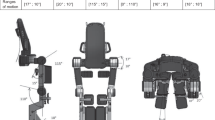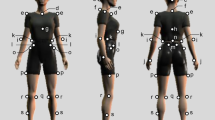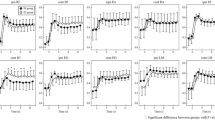Abstract
Study design
Descriptive study with cross-sectional data collection.
Objectives
To analyse and compare the 3D kinematics and kinetics of thorax, elbow and wrist, and the spatio-temporal parameters during swing-through gait (SG) and reciprocal gait (RG).
Setting
Hospital Nacional de Parapléjicos in Toledo, Spain.
Methods
An instrumented biomechanical analysis of the upper body of 15 adults with an incomplete lumbar or thoracic spinal cord injury was performed using a marker motion capture system and load cell crutches. Five walks of each gait pattern were analysed.
Results
The elbow was in flexion, valgus and pronation and the wrist was in extension and ulnar deviation in both SG and RG. Their kinematic patterns were quite similar, except in elbow valgus and wrist extension in which statistically significant differences were observed. In the thorax prevailed flexion movement in SG and rotation movement in RG. The reaction forces in the elbow and the wrist were notably higher in SG than in RG, but the joint moments were similar in both gait patterns.
Conclusions
SG showed greater demands and RG showed higher requirements on trunk motor control. In addition, SG could increase the probability of back and neck pain. Therefore RG should be recommended, whenever possible, in incomplete spinal cord injured people.
Rehabilitative management should consider adapting properly the crutch height and the inclination cane, loading the minimum weight on the crutches, using cushioning devices, reducing the duration of support phase, and limiting the overall use time of the crutches.
This is a preview of subscription content, access via your institution
Access options
Subscribe to this journal
Receive 12 print issues and online access
$259.00 per year
only $21.58 per issue
Buy this article
- Purchase on Springer Link
- Instant access to full article PDF
Prices may be subject to local taxes which are calculated during checkout



Similar content being viewed by others
Data availability
The datasets generated and analysed during the current study are available from the corresponding author on reasonable request
References
World Health Organization Collaborators. Spine Cord Injury [Internet]. 2013 [cited 2020 Oct 18]. Available from: https://www.who.int/es/news-room/fact-sheets/detail/spinal-cord-injury
National Spinal Cord Injury Statistical Center. Annual report. Complete public version. [Internet]. 2017. Available from: https://www.nscisc.uab.edu/
Joyce BM, Kirby RL. Canes, crutches and walkers. Am Fam Physician. 1991;43:535–42.
Smidt GL, Mommens MA. System of reporting and comparing influence of ambulatory aids on gait. Phys Ther. 1980;60:551–8.
Goldberg B, Hsu J. Atlas of Orthoses and Assistive Devices. 3rd ed. Philadelphia, PA: Mosby; 1997. 557–73 p.
Viosca E, Soler-García C, Prat J, Cortés A. Análisis de la marcha con ayudas a la deambulación, ortesis y calzado ortopédico. In: Prat J, editor. Biomecánica de la marcha humana normal y patológica. Instituto de Biomecánica de Valencia; 2013. p. 212–52.
Alcaraz-Rousselet MA. Rehabilitación de la lesión medular. In: Esclarín de Ruz A, editor. Lesión Medular: Enfoque multidisciplinario. Buenos Aires; Madrid: Médica Panamericana; 2009. p. 37–47.
Boninger ML, Cooper RA, Robertson RN, Rudy TE. Wrist biomechanics during two speeds of wheelchair propulsion: an analysis using a local coordinate system. Arch Phys Med Rehabil. 1997;78:364–72.
Dyson-Hudson TA, Kirshblum SC. Shoulder pain in chronic spinal cord injury, Part I: Epidemiology, etiology, and pathomechanics. J Spinal Cord Med. 2004;27:4–17.
Jain NB, Higgins LD, Katz JN, Garshick E. Association of shoulder pain with the use of mobility devices in persons with chronic spinal cord injury. PM R 2010;2:896–900.
Melis EH, Torres-Moreno R, Barbeau H, Lemaire ED. Analysis of assisted-gait characteristics in persons with incomplete spinal cord injury. Spinal Cord. 1999;37:430–9.
Opila KA, Nicol AC, Paul JP. Upper limb loadings of gait with crutches. J Biomech Eng. 1987;109:285–90.
Crosbie WJ, Nicol AC. Reciprocal aided gait in paraplegia. Paraplegia 1990;28:353–63.
Noreau L, Richards CL, Comeau F, Tardif D. Biomechanical analysis of swing-through gait in paraplegic and non-disabled individuals. J Biomech. 1995;28:689–700.
Payo I, Perez-Rizo E, Iglesias A, Sanchez-Sanchez B, Torres-Lacomba M, Gil-Agudo A. Point-mass biomechanical model of the upper extremity during Lofstrand crutch-assisted gait. IEEE Trans Neural Syst Rehabil Eng. 2020;28:3022–30.
Rasouli F, Reed KB. Walking assistance using crutches: A state of the art review. J Biomech. 2020;98:109489.
World Medical Association. World Medical Association Declaration of Helsinki: Ethical Principles for Medical Research Involving Human Subjects. JAMA. 2013;310:2191–4.
Kirshblum S, Burns S, Biering-Sørensen F, Donovan W, Graves D, Jha A, et al. International Standards for Neurological Classification of Spinal Cord Injury, Revised 2011. J Spinal Cord Med. 2011;34:535–46.
Compston J. Assessment of fracture risk and its application to screening for postmenopausal osteoporosis (WHO Technical Report Series No 843). Ann Rheum Dis. 1995;54:548.
O’Driscoll SW, Jupiter JB, King GJ, Hotchkiss RN, Morrey BF. The unstable elbow. Instructional course lectures. 2001.
Buckup J. Clinical Tests for the Musculoskeletal System. Clinical Tests for the Musculoskeletal System. 2019.
Hattam P, Smeatham A. Special Tests in Musculoskeletal Examination. Special Tests in Musculoskeletal Examination. 2010.
Perez-Rizo E, Trincado-Alonso F, Pérez-Nombela S, Del Ama-Espinosa A, Jiménez-Díaz F, Lozano-Berrio V, et al. Application of a model to analyze shoulder biomechanics in adult patients with spinal cord injury when walking with crutches in two different gait patterns. NeuroRehabilitation 2017;40:129–40.
Pérez-Rizo E, Solís-Mozos M, Belda-Lois JM, Page Á, Taylor J, Pons JL, et al. Instrumentation and biomechanical model for kinematic and kinetic analysis of upper limbs during gait with crutches. J Access Des All. 2013;3:127–48.
Slavens BA, Bhagchandani N, Wang M, Smith PA, Harris GF. An upper extremity inverse dynamics model for pediatric Lofstrand crutch-assisted gait. J Biomech. 2011;44:2162–7.
Requejo PS, Wahl DP, Bontrager EL, Newsam CJ, Gronley JK, Mulroy SJ, et al. Upper extremity kinetics during Lofstrand crutch-assisted gait. Med Eng Phys. 2005;27:19–29.
Wu G, Vanderhelm F, Dirkjanveeger H, Makhsous M, Vanroy P, Anglin C, et al. ISB recommendation on definitions of joint coordinate systems of various joints for the reporting of human joint motion?Part II: shoulder, elbow, wrist and hand. J Biomech. 2005;38:981–92.
Winter DA. Biomechanics and Motor Control of Human Movement. 4th ed. Winter DA, editor. Hoboken, NJ: John Wiley & Sons; 2009. 384 p.
Zatsiorsky VM. Kinetics of human motion. Champaign, Illinois: Human kinetics; 2002.
Dittuno PL, Dittuno JF. Walking index for spinal cord injury (WISCI II): Scale revision. Spinal Cord. 2001;39:654–6.
Kim MO, Burns AS, Ditunno JF, Marino RJ. The Assessment of Walking Capacity Using the Walking Index for Spinal Cord Injury: Self-Selected Versus Maximal Levels. Arch Phys Med Rehabil. 2007;88:762–7.
Hall KM, Cohen ME, Wright J, Call M, Werner P. Characteristics of the functional independence measure in traumatic spinal cord injury. Arch Phys Med Rehabil. 1999;80:1471–6.
Barthel D, Mahoney F. Functional evaluation: The Barthel Index. Md State Med J 1965;14:61–5.
Rossier P, Wade DT. Validity and reliability comparison of 4 mobility measures in patients presenting with neurologic impairment. Arch Phys Med Rehabil. 2001;82:9–13.
Van Hedel HJA, Dietz V, Curt A. Assessment of walking speed and distance in subjects with an incomplete spinal cord injury. Neurorehabil Neural Repair. 2007;21:295–301.
Goldberg B, LeBlanc M, Edelstein J. Canes, crutches, and walkers. In: Goldberg B, Hsu J, editors. Atlas of orthoses and assistive devices. 3rd ed. St Louis: Mosby-Year Book; 1997. p. 557–74.
Hall J, Clarke A, Harrison R. Guide lines for prescription of walking frames. Physiotherapy 1990;76:118–20.
Haubert LL, Gutierrez DD, Newsam CJ, Gronley JK, Mulroy SJ, Perry J. A comparison of shoulder joint forces during ambulation with crutches versus a walker in persons with incomplete spinal cord injury. Arch Phys Med Rehabil. 2006;87:63–70.
Slavens BA, Sturm PF, Harris GF. Upper extremity inverse dynamics model for crutch-assisted gait assessment. J Biomech. 2010;43:2026–31.
Dalyan M, Cardenas DD, Gerard B. Upper extremity pain after spinal cord injury. Spinal Cord. 1999;37:191–5.
Sie IH, Waters RL, Adkins RH, Gellman H. Upper extremity pain in the postrehabilitation spinal cord injured patient. Arch Phys Med Rehabil. 1992;73:44–8.
Slavens BA, Frantz J, Sturm PF, Harris GF. Upper extremity dynamics during Lofstrand crutch-assisted gait in children with myelomeningocele. J Spinal Cord Med. 2007;30:S165–71.
Slavens BA, Sturm PF, Bajournaite R, Harris GF. Upper extremity dynamics during Lofstrand crutch-assisted gait in children with myelomeningocele. Gait Posture. 2009;30:511–7.
Konop KA, Strifling KMB, Wang M, Cao K, Schwab JP, Eastwood D, et al. A biomechanical analysis of upper extremity kinetics in children with cerebral palsy using anterior and posterior walkers. Gait Posture. 2009;30:364–9.
Strifling KMB, Lu N, Wang M, Cao K, Ackman JD, Klein JP, et al. Comparison of upper extremity kinematics in children with spastic diplegic cerebral palsy using anterior and posterior walkers. Gait Posture. 2008;28:412–9.
Bhagchandani N, Slavens B, Wang M, Harris G. Upper extremity biomechanical model of crutch-assisted gait in children. Proc 31st Annu Int Conf IEEE Eng Med Biol Soc Eng Futur Biomed EMBC. 2009;2009:7164–7.
Zambudio Periago R. Ayudas para la marcha. In: Prótesis ortesis ayudas técnicas de zambudio. 2009. p. 301–7.
Faruqui SR, Jaeblon T. Ambulatory assistive devices in orthopaedics: uses and modifications. J Am Acad Orthop Surg. 2010;18:41–50.
Liew BXW, Rugamer D, Stocker A, De Nunzio AM. Classifying neck pain status using scalar and functional biomechanical variables – development of a method using functional data boosting. Gait Posture. 2020;76:146–50.
Yeung EH, Chow DH, Su IY. Kinematic and electromyographic studies on unaided, unilateral and bilateral crutch walking in adolescents with spastic diplegia. Prosthet Orthot Int. 2012;36:63–70.
Hash TW, Bogner EA. Nerve entrapment and compression syndromes of the elbow. Semin Musculoskelet Radio. 2010;14:438–48.
Antuña S. Biomecánica del codo y sus implicaciones en el diseño de recambios articulares. Biomecánica. 2005;12:35–9.
Hernández Barrios D. Biomecánica del complejo articular del codo. Musculatura responsable de los movimientos y acciones asociadas [Internet] http://www.sld.cu/sitios/rehabilitacion-bio/temas.php?idv=18660 [cited 2020 Jul 2]. Available from
Werner R, Waring W, Davidoff G. Risk factors for median mononeuropathy of the wrist in postpoliomyelitis patients. Arch Phys Med Rehabil. 1989;70:464–7.
Perry J. Gait Analysis: Normal and Pathological Function. Journal of Pediatric Orthopaedics. Perry J, Burnfield JM, editors. Journal of Sport Science & Medicine. New Jersey; 2010.
Sánchez-Lacuesta J, Prat J, Hoyos JV, Viosca E, Soler-Gracia C, Comín M, et al. Biomecánica de la marcha humana y patológica. Prat J, editor. Valencia: Instituto de Biomecánica de Valencia; 2013.
Acknowledgements
The authors thank Soraya Martín, Vicente Lozano and Fernando Trincado who were involved in the data collection.
Funding
The authors disclosed receipt of the following financial support for the research, authorship, and/or publication of this article: This work was supported by the Consejería de Sanidad of Junta de Comunidades de Castilla-La Mancha (Spain) under contract no. PI/2016/050. The funders played no role in the design, conduct, or reporting of this study.
Author information
Authors and Affiliations
Contributions
E.P.: Idea, conception and design of the study, design of the biomechanical model, acquisition of data, analysis and interpretation, drafting the manuscript; M.T.: Supervision, support in terms of spinal cord injury, analysis and interpretation, drafting the manuscript; I.P.: Design of the biomechanical model, interpretation of data, revision of the manuscript; A.G.: Design of the study, interpretation of data, supervision in terms of spinal cord injury, revision of the manuscript; B.S.: Design of the study, analysis and interpretation, analysis and interpretation, drafting the manuscript.
Corresponding author
Ethics declarations
Competing interests
The authors declare no competing interests.
Ethical approval
The study protocol was approved by the Clinical Research Committee of Hospital Virgen de la Salud of Toledo (86/10). The study complies with the Declaration of Helsinki.
Additional information
Publisher’s note Springer Nature remains neutral with regard to jurisdictional claims in published maps and institutional affiliations.
Rights and permissions
Springer Nature or its licensor (e.g. a society or other partner) holds exclusive rights to this article under a publishing agreement with the author(s) or other rightsholder(s); author self-archiving of the accepted manuscript version of this article is solely governed by the terms of such publishing agreement and applicable law.
About this article
Cite this article
Pérez-Rizo, E., Torres-Lacomba, M., Payo, I. et al. A comparison of elbow and wrist kinematics and kinetics during swing-through versus reciprocal gait with crutches in persons with incomplete spinal cord injury. Spinal Cord 61, 391–398 (2023). https://doi.org/10.1038/s41393-023-00902-5
Received:
Revised:
Accepted:
Published:
Issue Date:
DOI: https://doi.org/10.1038/s41393-023-00902-5



